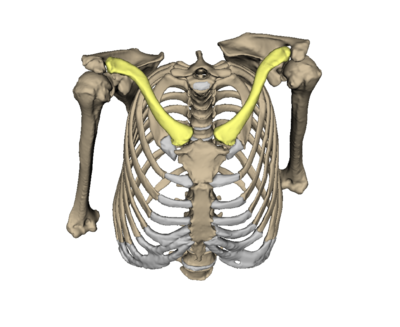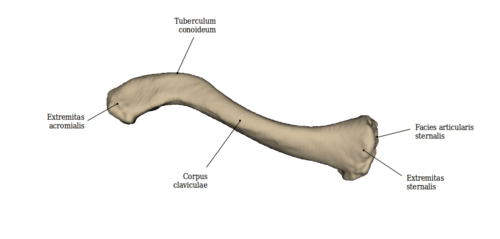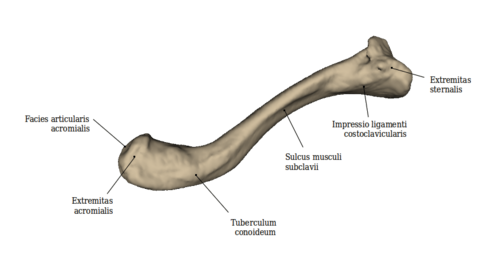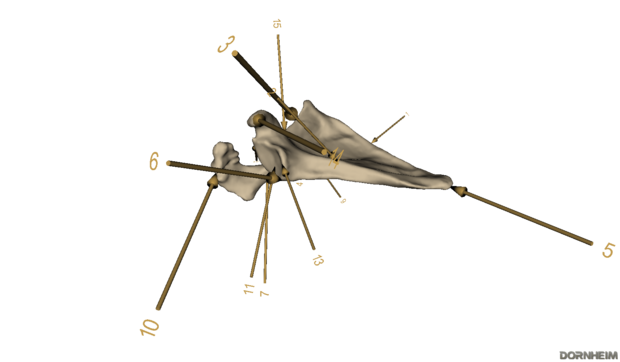Shoulder girdle
Clavicle
The clavicle is an "S"-shaped curved bone. It has a convexity medial to the front, which takes about 2/3 of the length. A concavity exists laterally to the front.
There is the plump Extremitas sternalis facing the sternum and the flat Extremitas acromialis facing the scapula, with the Corpus claviculae in between. At the sternal end is an approximately three-sided articular surface, Facies articularis sternalis. The Facies articularis acromialis is approximately oval.
On the undersurface of the clavicle there is the tuberosity lig. costoclavicularis near the extremitas sternalis . The Sulcus m. subclavii is found on the undersurface of the Corpus claviculae. Near the acromial end there is a hump on the lower surface, Tuberculum conoideum. The Linea trapezoidea is located in front and laterally of the tubercle.
To explore the clavicles click here and start the web viewer.
Shoulder blade (Scapula)
The shoulder blade, scapula, is a flat three-sided bone whose margins, margo medialis (1), margo lateralis (2) and margo superior (3), are separated by angles, Angulus superior (4), Angulus inferior (5) and the bevelled Angulus lateralis (6).
The anterior surface, the Facies costalis, is flat and slightly hollowed (Fossa subscapularis). It sometimes shows well-formed line musculares. The facies posterior is divided by the shoulder bones, spina scapulae (7), into a smaller fossa supraspinata (8) and a larger fossa infraspinata (9). The spina scapulae begins with a triangular field (trigonum spinae) on the medial side, increases laterally in height and ends with a flattened extension, the shoulder height, acromion (10).
Close to the lateral end is an oval articular surface for connection to the clavicle, the Facies articularis clavicularis.
Der Angulus acromii ist ein leicht tastbarer Knochenpunkt, der jene Stelle markiert, an dem der laterale Rand des Acromion in die Spina scapulae übergeht. Am Angulus lateralis liegt die Gelenkpfanne, die Cavitas glenoidalis (11). An deren Oberrand zeigt sich ein kleines Höckerchen, das Tuberculum supraglenoidale (12). Unterhalb der Cavitas findet sich das Tuberculum infraglenoidale (13). Anschließend an die Cavitas glenoidalis liegt der Hals der Scapula, Collum scapulae. Über der Cavitas glenoidalis erhebt sich der Rabenschnabelfortsatz, Processus coracoideus (14). Er biegt rechtwinkelig nach lateroventral um und endet abgeplattet. Gemeinsam mit dem Acromion bildet er einen Schutz für das darunter liegende Gelenk. Medial von der Basis des Processus coracoideus findet sich im Margo superior ein Einschnitt, Incisura scapulae (15). Die knöcherne Gelenkpfanne Cavitas glenoidalis (11) der Articulatio humeri, eines Kugelgelenkes, ist wesentlich kleiner als der Humeruskopf. Die Pfanne wird durch eine faserknorpelige Gelenklippe, Labrum glenoidale, vergrößert. Die Oberfläche der Cavitas glenoidalis beträgt ca. 6qcm. Das Gewicht der oberen Extremität beträgt etwa 4 kg. Da keine stärkeren Bänder vorhanden sind, müssen die Muskeln, die das Gelenk umhüllen, dieses sichern. Man spricht daher von einem muskelgesicherten Gelenk. Die sogenannte "Rotatorenmanschette" ist Teil dieser muskulären Sicherung und verstärkt im besonderen die Gelenkkapsel.
Das Caput humeri ist annähernd kugelförmig. Die synoviale Gelenkkapsel ist am Labrum glenoidale der Scapula befestigt. Bewegungen in drei Freiheitsgraden sind möglich. Man spricht von Abduktion und Adduktion, wobei man von der Ruhestellung des Caput humeri in der Skapularebene ausgeht. Man kennt die Anteversion, das nach vorne Heben des Armes und ihre Gegenbewegung, die Retroversion. Durch eine rotatorische Komponente ergibt sich unter Mitwirkung der vorher genannten Bewegungen eine zusammengesetzte Bewegung, die Zirkumduktion oder das Kreisen, wobei der Arm praktisch einen Kegelmantel beschreibt.
Bei den Abduktionsbewegungen kommt es immer zu einer Mitbewegung der Scapula; eine exzessive Mitbewegung der Scapula tritt bei einer Abduktion über 90 Grad ein (Elevation).
weiterführende Links



